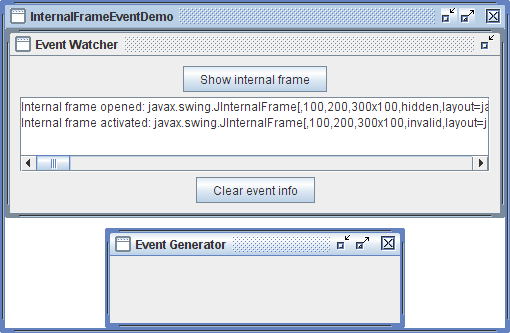How to Write an Internal Frame Listener
InternalFrameListener is similar to a
WindowListener. Like the window listener,
the internal frame listener listens for events that
occur when the "window" has been shown for the first time,
disposed of, iconified, deiconified, activated, or deactivated.
Before using an internal frame listener,
please familiarize yourself with
the WindowListener interface in
How to Write Window Listeners.
The application shown in the following figure demonstrates internal frame events. The application listens for internal frame events from the Event Generator frame, displaying a message that describes each event.

Try this:
- Click the Launch button to run InternalFrameEventDemo using
Java™ Web Start (download JDK 6).
Alternatively, to compile and run the example yourself, consult the
example index.

- Bring up the Event Generator internal frame
by clicking the Show internal frame button.
You should see an "Internal frame opened" message in the display area. - Try various operations to see what happens.
For example, click the Event Generator
so that it gets activated.
Click the Event Watcher so that the
Event Generator gets deactivated.
Click the Event Generator's decorations to
iconify, maximize, minimize, and close the window.
See How to Write Window Listeners for information on what kinds of events you will see.
public class InternalFrameEventDemo ...
implements InternalFrameListener ... {
...
public void internalFrameClosing(InternalFrameEvent e) {
displayMessage("Internal frame closing", e);
}
public void internalFrameClosed(InternalFrameEvent e) {
displayMessage("Internal frame closed", e);
listenedToWindow = null;
}
public void internalFrameOpened(InternalFrameEvent e) {
displayMessage("Internal frame opened", e);
}
public void internalFrameIconified(InternalFrameEvent e) {
displayMessage("Internal frame iconified", e);
}
public void internalFrameDeiconified(InternalFrameEvent e) {
displayMessage("Internal frame deiconified", e);
}
public void internalFrameActivated(InternalFrameEvent e) {
displayMessage("Internal frame activated", e);
}
public void internalFrameDeactivated(InternalFrameEvent e) {
displayMessage("Internal frame deactivated", e);
}
void displayMessage(String prefix, InternalFrameEvent e) {
String s = prefix + ": " + e.getSource();
display.append(s + newline);
}
public void actionPerformed(ActionEvent e) {
if (SHOW.equals(e.getActionCommand())) {
...
if (listenedToWindow == null) {
listenedToWindow = new JInternalFrame("Event Generator",
true, //resizable
true, //closable
true, //maximizable
true); //iconifiable
//We want to reuse the internal frame, so we need to
//make it hide (instead of being disposed of, which is
//the default) when the user closes it.
listenedToWindow.setDefaultCloseOperation(
WindowConstants.HIDE_ON_CLOSE);
listenedToWindow.addInternalFrameListener(this);
...
}
}
...
}
}
The Internal Frame Listener API
The InternalFrameListener Interface
The corresponding adapter class is
InternalFrameAdapter.
| Method | Purpose |
|---|---|
| internalFrameOpened(InternalFrameEvent) | Called just after the listened-to internal frame has been shown for the first time. |
| internalFrameClosing(InternalFrameEvent) | Called in response to a user request that the listened-to
internal frame be closed.
By default, JInternalFrame
hides the window when the user closes it.
You can use the JInternalFrame
setDefaultCloseOperation
method to specify another option,
which must be either DISPOSE_ON_CLOSE
or DO_NOTHING_ON_CLOSE
(both defined in WindowConstants,
an interface that
JInternalFrame implements).
Or by implementing an internalFrameClosing
method in the internal frame's listener,
you can add custom behavior
(such as bringing up dialogs or saving data)
to internal frame closing.
|
| internalFrameClosed(InternalFrameEvent) | Called just after the listened-to internal frame has been disposed of. |
|
internalFrameIconified(InternalFrameEvent) internalFrameDeiconified(InternalFrameEvent) |
Called just after the listened-to internal frame is iconified or deiconified, respectively. |
|
internalFrameActivated(InternalFrameEvent) internalFrameDeactivated(InternalFrameEvent) |
Called just after the listened-to internal frame is activated or deactivated, respectively. |
Each internal frame event method has a single parameter: an
InternalFrameEvent object.
The InternalFrameEvent class defines no generally
useful methods. To get the internal frame that fired the event,
use the getSource method,
which InternalFrameEvent inherits from
java.util.EventObject.
Examples that Use Internal Frame Listeners
No other source files currently contain internal frame listeners.
However, internal frame listeners are very similar to
WindowListeners and several Swing programs have
window listeners:
| Example | Where Described | Notes |
|---|---|---|
InternalFrameEventDemo
|
This section | Reports all internal frame events that occur on one internal frame to demonstrate the circumstances under which internal frame events are fired. |
DialogDemo
|
Text Component Features |
CustomDialog.java uses setDefaultCloseOperation instead
of a window listener to determine what action to take
when the user closes the window.
|
SliderDemo
|
How to Use Sliders | Listens for window iconify and deiconify events, so that it can stop the animation when the window is not visible. |
